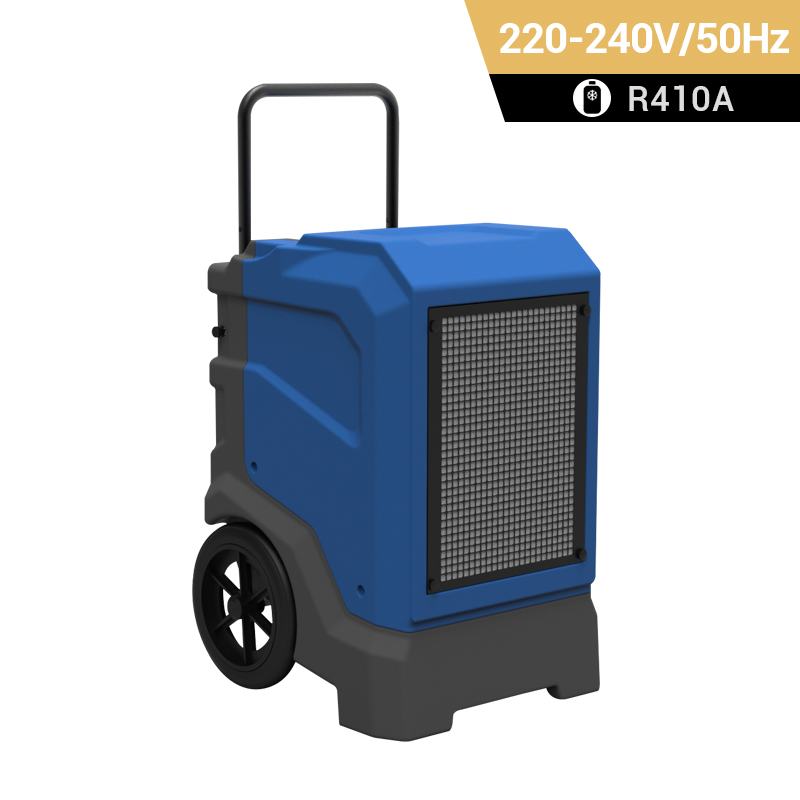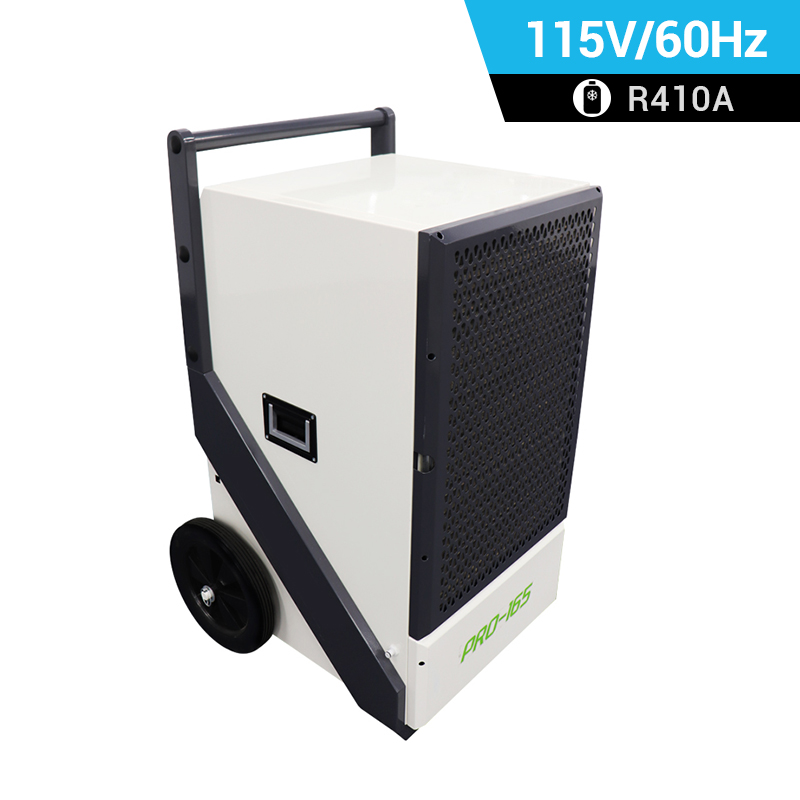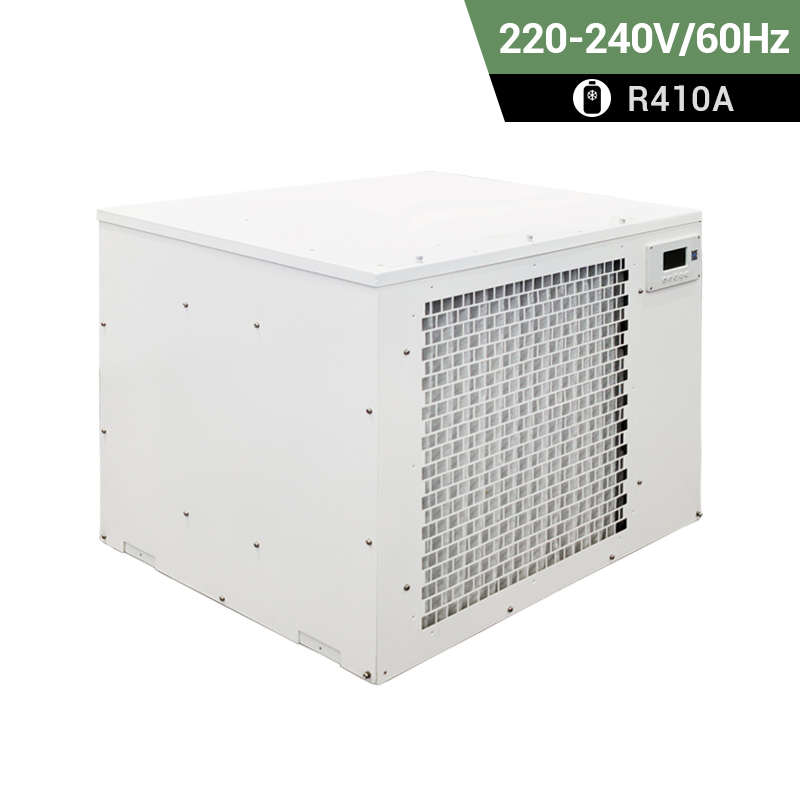How Does a Dehumidifier Work?
A dehumidifier machine is a device designed to reduce the humidity levels in a room or an enclosed space. It dehumidifies by pulling moisture-laden air through the machine, removing the excess moisture, and then releasing drier air back into the environment.
Working processes of a refrigerant dehumidifier:
1. The dehumidifier draws in air from the surrounding environment using a fan, which is typically warm and humid. 2. The incoming warm, humid air passes over a set of cold coils within the dehumidifier. These coils are filled with a refrigerant. When the warm air meets the cold surface of the coils, the moisture in the air condenses into water droplets. 3. The condensed moisture forms into water droplets, which collect in a drip pan or reservoir located at the bottom of the dehumidifier. This collected water is then removed from the machine, often through a drain hose or a removable tank that needs to be emptied periodically. 4. After the moisture is removed, the now drier air is reheated and then released back into the room. This helps to maintain a comfortable temperature level. 5. Many dehumidifiers are equipped with a humidistat. This allows the dehumidifier to operate until the desired humidity level is reached, at which point it will either shut off or enter a lower power mode to conserve energy. 6. The fan continues to circulate air through the dehumidifier, ensuring that the process continues until the target humidity level is achieved.
How to Use Dehumidifier Effectively?
Using a dehumidifier effectively involves a combination of proper placement, settings adjustment, and regular maintenance.
● Select a good dehumidifier with a capacity appropriate for the size of the room or area you want to dehumidify.
● Place the indoor dehumidifier in the area with high humidity levels. Common areas include basements, crawl spaces, bathrooms, laundry rooms, and spaces prone to moisture accumulation.
● Keep doors and windows closed while the dehumidifier is running to prevent outside humid air from entering. However, ensure there is enough airflow within the room to allow the dehumidifier to work effectively.
● If your dehumidifier has a humidistat, set it to your desired humidity level (usually between 30-50%). The dehumidifier will work until this level is reached, then it will shut off or enter a lower power mode.
● If the dehumidifier has a water tank, check it regularly and empty it when it's full. Some models also have an auto-shutoff feature when the tank is full.
● If the sustainable dehumidifier has a continuous drainage system, it uses a hose and directs the water to a drain or outside. This ensures the commercial dehumidifier with drain hose operates without interruption.
● Clean the air filter regularly to maintain optimal performance. A clogged filter can reduce efficiency. Some models have washable filters (e.g. SUS304, nylon), while others may require replacement.
● If you notice frost forming on the coils, turn off the dehumidifier and allow it to thaw. Frost can reduce the unit's efficiency.
● Keep an eye on the humidity levels in the room. If you find that the dehumidifier is not achieving the desired level, you may need to adjust the settings or consider using a larger unit.
● Ensure the room maintains a reasonable temperature (typically above 60℉ or 15℃). Dehumidifiers may not work effectively in very cold environments.
● Consider using the smart dehumidifier in conjunction with other moisture-reducing methods, such as using centrifugal air movers in bathrooms, fixing leaks, and sealing windows and doors.
Regular Dehumidifier Maintenance
Proper maintenance of a dehumidifier is crucial to ensure it continues to operate efficiently and effectively.
1. Regular Cleaning the water collection tank
2. Clean or Replace the Air Filter
3. Inspect and Clean the Coils
4. Check for Frost Buildup
5. Inspect the Drainage System
6. Inspect the Power Cord
7. Clean the Exterior and Air Vents
8. Check for Leaks
9. Inspect the Humidistat and Controls
10. Store Properly
11. Follow Manufacturer's Recommendations
Regular maintenance not only ensures the dehumidifier’s efficient operation but also helps extend its lifespan.
How to Size a Dehumidifier?
Sizing a dehumidifier involves calculating the pint capacity needed to effectively remove moisture from a specific area.
● Measure the length and width of the space you want to dehumidify. Multiply these measurements to find the square footage (length x width = square footage).
● Consider the relative humidity level you want to achieve in the space. A comfortable range is typically 30% - 50%. The higher the humidity level, the more powerful the dehumidifier you'll need.
● If the area is extremely damp, has poor ventilation, or experiences high levels of moisture, you may want to opt for a high capacity dehumidifier.
● In very humid or wet environments, like basements prone to flooding, it's advisable to choose a higher-capacity unit. You might also consider a humidity remover designed for use in extreme conditions.
● If the space is open or connects to other rooms, consider the overall square footage. Dehumidifiers are most effective in enclosed spaces, so you may need a large capacity dehumidifier if the area is not well-contained.
● Consult the manufacturer's specifications and recommendations for their specific models. They often provide guidelines for the square footage and humidity levels their units are designed to handle.
● Think about features like a built-in pump for continuous drainage, auto-defrost function for use in colder environments, and adjustable fan speeds.
● Once you've determined the appropriate capacity, you can confidently purchase the dehumidifier. Preair provides wholesale portable dehumidifiers for sale. We are looking forward to cooperate with dealers, retailers and bulk buyers.
Recommended Dehumidifiers
Dehumidifiers can help prevent issues such as mold growth, musty odors, and damage to furniture or structural elements caused by high humidity levels. There are some highly-rated dehumidifiers for your choice:
LGR energy efficient dehumidifiers: cart-shape, rotational-molded body, continuous drainage, timing, high-efficient, specially designed for water damage restoration, dehumidification capacities range from 80 to 165 PPD.
PR energy saving dehumidifiers: cart-shape, sheet metal housing, water tank or continuous drainage, timing, specially designed for areas with a lot of rainfall in winter, dehumidification capacities range from 30 to 80 PPD.
PRO high capacity dehumidifiers: ceiling-mounted, sheet metal housing, continuous drainage, timing, remote control, MERV11 filter, with a large capacity ranges from 230 to 500 PPD, specially used for large greenhouses.
ZETA automatic dehumidifiers: ceiling-mounted, sheet metal housing, continuous drainage, timing, remote control, nylon filter, specially designed for greenhouses in SE Asia, with a capacity ranges from 145 to 480 PPD.
Before purchasing dehumidifiers, remember to consider factors such as the size of the space you need to dehumidify, the level of humidity in the area, and any specific features you may require (e.g., continuous drainage, auto-defrost function, adjustable fan speeds). Contact us if you have any questions about dehumidifiers!
 +86-13376814803
+86-13376814803  robert@hzhongtai.com
robert@hzhongtai.com 























